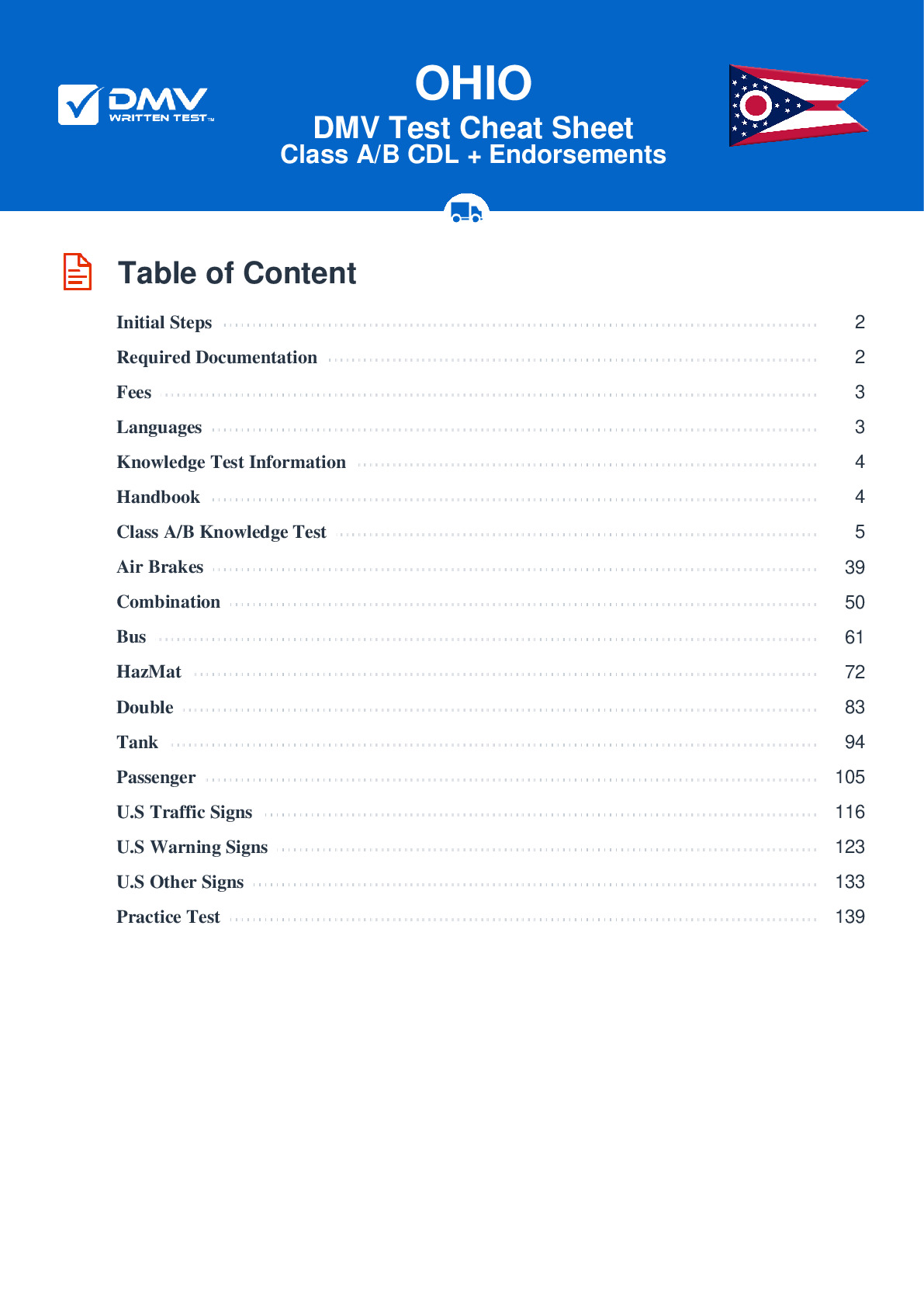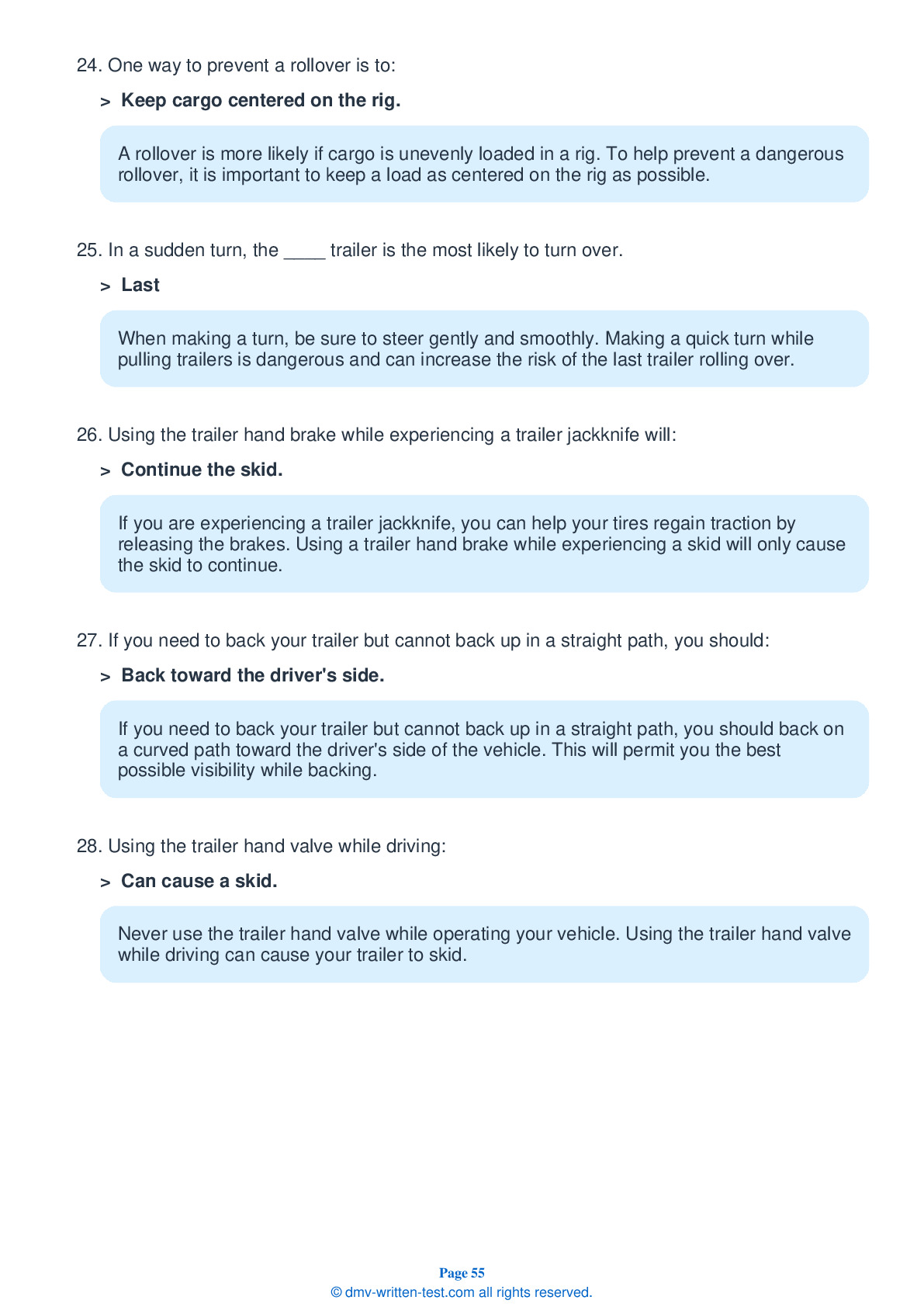Knowledge Test Class A
This license is required for driving any legal combination of vehicles, with a gross combination weight rating of 26,001 pounds or more, provided the GVWR of a trailer exceeds 10,000 pounds. To receive this license, applicants must pass a 50-question test. Test questions come from the Ohio Commercial Drivers License Manual. To pass, applicants must answer 40 questions correctly. Questions come from chapters covering: Introduction, Driving Safely, Transporting Cargo Safely, Air Brakes (if applicable), Combination Vehicles, Pre-Trip Vehicle Inspection Test, Basic Vehicle Control Skills Test and On-Road Driving. Endorsements that may be used with a Class A CDL are: Hazardous materials, Tank, Passenger, Doubles/Triples, HazMat, Tank, Air Brakes and School bus.
1. Which of the following is not a cause of hydraulic brake failure?
Most cases of hydraulic brake failure come from one of two causes. The brakes may fail due to a loss of hydraulic pressure or due to overuse on long hills, causing the brakes to fade.
2. When backing a truck, you should:
When backing a truck, always use the mirrors on both sides of the vehicle. Have someone help you whenever possible.
3. To prevent your vehicle from rolling backward when beginning to move, you can:
To ensure that your vehicle does not roll backward when beginning to move after a stop, you should partly engage the clutch before removing your right foot from the brake pedal.
4. If you realize you may be running late to your destination, you should:
To reduce the risk of developing aggressive driving behavior, you should take measures to manage your stress. One strategy to do this is to simply take a deep breath and accept your circumstances if you realize you will be late to your destination.
5. Regrooved tires:
Regrooved, recapped, or retreaded tires are prohibited on the front wheels of a bus.
6. What tells you how much pressure is in your vehicle's air tanks?
A vehicle that is equipped with air brakes must also be equipped with a supply pressure gauge. This gauge tells the driver how much air pressure is in each of the vehicle's air tanks.
7. What should you do if your vehicle gets stuck on railroad tracks?
If your CMV gets stuck on railroad tracks, you should immediately leave the vehicle and get away from the tracks. Check the signposts or signal housing at the crossing for emergency contact information and call 911, or another appropriate emergency number.
Frequently Asked Questions
To obtain a Class A CDL in Ohio, you must:
1. Be at least 18 years old (21 years old for interstate driving).
2. Hold a valid Ohio driver’s license.
3. Obtain a Commercial Learner’s Permit (CLP) by passing a written test and obtaining a medical certificate.
4. Complete a minimum of 160 hours of training from an approved driving school or a training program.
5. Pass a skills test that includes a pre-trip inspection, basic vehicle control, and on-road driving test.
6. Submit the required documentation and pay the necessary fees.
It's important to note that there may be additional requirements or restrictions based on your specific situation and the type of commercial vehicle you plan to operate.
1. Tractor-trailers
2. Truck and trailer combinations
3. Livestock carriers
4. Tanker trucks
5. Flatbeds with oversized loads
6. Double or triple trailers
It's important to note that there may be additional endorsements or certifications required to operate certain types of commercial vehicles, such as hazardous materials or passenger vehicles. It's always best to check with the Ohio Bureau of Motor Vehicles (BMV) for specific requirements and regulations.
1. Be at least 18 years old (21 years old for interstate driving)
2. Have a valid Ohio driver’s license
3. Obtain a Commercial Learner’s Permit (CLP) by passing a written test and obtaining a medical certificate
4. Complete a minimum of 160 hours of training from an approved driving school or training program
5. Pass a skills test that includes a pre-trip inspection, basic vehicle control, and on-road driving test
6. Submit the required documentation and pay the necessary fees
Additionally, you must pass a vision test and provide proof of citizenship or legal presence in the United States. You must also provide your Social Security Number and disclose any medical conditions that may affect your ability to drive safely.
It's important to note that there may be additional requirements or restrictions based on your specific situation and the type of commercial vehicle you plan to operate.
Drivers who are 21 years old or older can operate commercial vehicles across state lines and transport hazardous materials or oversized loads, provided they meet all other federal and state requirements.
The most common CDL endorsements include:
1. T - Double/Triple Trailers: This endorsement is required for drivers who plan to operate double or triple trailers.
2. P - Passenger: This endorsement is required for drivers who plan to transport passengers in a commercial vehicle, such as a bus.
3. N - Tank Vehicles: This endorsement is required for drivers who plan to transport liquids or gases in bulk containers.
4. H - Hazardous Materials: This endorsement is required for drivers who plan to transport hazardous materials.
5. X - Combination of Tank Vehicle and Hazardous Materials: This endorsement is required for drivers who plan to transport both hazardous materials and liquids or gases in bulk containers.
It's important to note that each endorsement requires passing a written test and meeting other requirements, such as background checks and additional training.
1. Pre-Trip Inspection: The pre-trip inspection evaluates the driver's ability to inspect the vehicle for safety hazards and mechanical issues before operating it. The driver must identify and explain the function of various parts of the vehicle, such as brakes, steering, lights, and tires.
2. Basic Vehicle Control: The basic vehicle control test evaluates the driver's ability to control the vehicle in various situations, such as backing up, turning, and maneuvering in tight spaces. The driver must demonstrate proper techniques for shifting gears, accelerating, braking, and steering.
3. On-Road Driving: The on-road driving test evaluates the driver's ability to safely operate the vehicle in traffic on public roads. The driver must demonstrate proper lane positioning, signaling, speed control, and hazard recognition.
Each part of the skills test is scored separately, and drivers must pass all three parts to obtain a Class A CDL. It's important to note that drivers must also meet other requirements before taking the skills test, such as completing a certified CDL training program and passing a written knowledge test.
1. Air Brake Restriction: If a driver did not pass the air brake knowledge and skills tests, they will have an "L" restriction on their license, which prohibits them from operating commercial vehicles equipped with air brakes.
2. Manual Transmission Restriction: If a driver takes the road test in a commercial vehicle with an automatic transmission, they will have an "E" restriction on their license, which prohibits them from operating a commercial vehicle with a manual transmission.
3. Intrastate Only Restriction: If a driver only intends to operate commercial vehicles within the state of Ohio, they may have an "O" restriction on their license.
4. Medical Certification Requirement: All CDL holders, including Class A drivers, are required to undergo a medical examination and maintain a valid medical certificate.
5. Hazmat Endorsement Background Check: If a driver has a hazardous materials endorsement on their CDL, they must undergo a background check every five years to maintain the endorsement.
It's important for drivers to be aware of any restrictions or limitations on their license and comply with all regulations to avoid penalties or fines.
However, Ohio offers a CDL Manual in several languages, including Spanish, French, Russian, and Somali. This manual can help non-English speaking applicants understand the rules and regulations of commercial driving.
If an applicant needs assistance reading and understanding the CDL Manual or has difficulty communicating in English during the written test, they may bring an interpreter with them to the testing location. The interpreter must be fluent in both English and the applicant's preferred language and cannot be a family member or friend of the applicant.
To request accommodations, the applicant must complete and submit an Application for Reasonable Accommodations form to the BMV. The form requires information about the applicant's disability, the specific accommodations needed, and any supporting documentation from a qualified medical professional.
Examples of accommodations that may be provided include a separate testing room, extended testing time, or a sign language interpreter. The BMV will review the application and determine which accommodations are reasonable and necessary based on the applicant's disability and needs.
It's important to note that the BMV may require additional documentation or information to support the accommodation request. Applicants should submit their application as early as possible to allow time for processing and review.
If you fail the test three times, you must wait at least 30 days before attempting to take it again. Additionally, you will be required to pay a fee each time you take the test.
It's important to note that if you fail the written test, you will not be allowed to take the skills test until you pass the written test. Therefore, it's essential to study and prepare adequately before taking the test.
If you need help studying for the Class A CDL written test, Ohio offers a free CDL practice test on their website, which can help familiarize you with the types of questions that will be on the actual exam. Additionally, there are many commercial study materials available, including books and online courses that can help you prepare for the exam.




